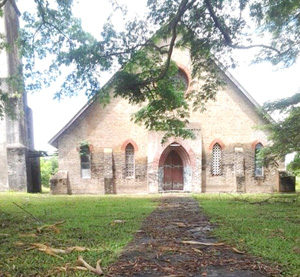Leguan Island is one of the over 300 islands found in the mighty Essequibo River. With 18 square miles in size and a population of approximately 3000 residents, it is but one of the few found in the river’s delta, just as it flows into the Atlantic Ocean.
First occupied predominantly by the Dutch before Britain took over, the Island’s population currently stands at a proportion of 80% East Indians and 15% of African descent; the remainder is mixed. Just about 30 years ago however, the island had a population of over 8000 with 36 villages but due to continuous migration, some of the villages were abandoned and only about 27 remain to date.

History has it that when the Dutch first settled there, they say such a large amount of iguanas that they decided to name the island Leguan which literally translates to “Land of the Iguanas.” Some things don’t change, nor has the abundance of iguanas on the island; for they can still be found sometimes on the roads, some as long as 5 feet.
The main economic activity on this peaceful island is agriculture, which first started with the Dutch who used the lands to cultivate cotton. When the cotton industry failed, attention was turned to sugar and when that was phased out, rice cultivation became dominant. Even so, to this day, rice remains the main crop, among others. Residents who do not engage in rice cultivation also take part in cattle-rearing, livestock and cash crops cultivation, as well as the hunting of iguanas which are in abundance on the island, to sustain their livelihoods.
Sure enough there are Nursery, Primary and Secondary Schools but if residents want to continue at a tertiary level, they are forced to leave and some choose to stay on the mainland even after.
Leguan is one of the very unique places in Guyana when it comes to security. Thefts and robberies are practically non-existent on the island and many residents sleep with the doors of their homes open. At about 05:00 hrs, residents on the island are in their farms, working until 09:00 hrs before returning home for a rest. At 15:00 hrs they return to the field and work until 18:00hrs. During the downtime, farmers usually meet to socialise under a big tree or in a nearby bar.
While most of the historical buildings on the island have been consumed by the elements, the St. Peter’s Anglican Church still stands but is in need of urgent repairs. Along the beaches and foreshore of the islands, Dutch bottles, seals, coins and other artifacts can be found. Leguan has a police station, a cottage hospital, nursery, primary and secondary schools, a Magistrates court, a guesthouse, a plantain chip factory, rice mills and religious places of worship. It also houses the tallest statue of the Hindu god, Hanuman, in the country.
Quite recently, the delegates of the 2018 Miss Earth Pageant ventured to the fascinating island as part of an Eco Tour. (Guyana Premier )



